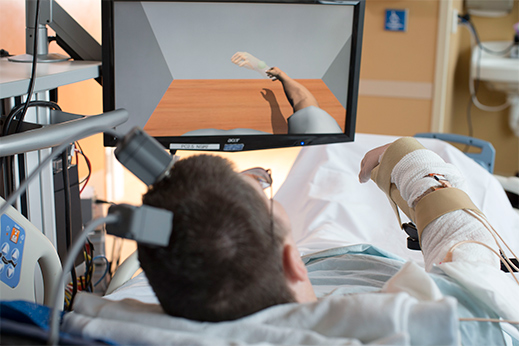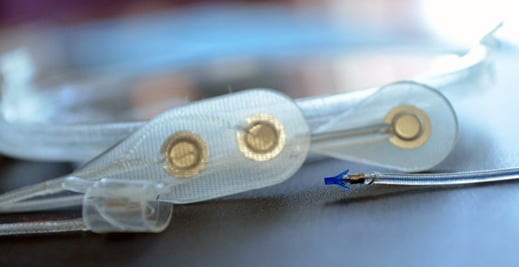Paralyzed Man’s Arm Wired to Receive Brain Signals
Scientists at Case Western Reserve University in Ohio say they’ve used electronics to get around a paralyzed man’s spinal injury, permitting him to use an implant in his brain to move his arm and hand.

The test represents the first time that signals collected in the brain have been conveyed directly to electrodes placed inside someone’s arm to restore movement, says Robert Kirsch, a biomedical engineer at Case Western. He also directs the Cleveland FES Center, which develops technologies for people with paralysis.
The project, described today at the meeting of the Society for Neuroscience in Chicago, is a step toward a wireless system able to transmit brain signals through the air to electronics sewn into the limbs of paralyzed people, thereby restoring the ability to carry out simple daily tasks.
People familiar with the study’s results said the volunteer’s movements are still rough, and not well coӧrdinated. “It’s not a fluid natural movement like you are picking up a cup of coffee to drink it,” says John Donoghue, one of the leaders of BrainGate, a consortium that is developing brain-computer interfaces and includes the Case Western team. “But the fact that they got a person to control their own body, to stimulate muscles in a specific way to make them move, and do it from a small patch of brain, is incredible.”

Volunteers in brain-implant studies have previously moved computer cursors and controlled robotic arms. Last year, a different Ohio man with partial arm paralysis received a brain implant and was able to mentally open and close his hand using strips of external electrodes placed around his forearm. That effort, called Neurobridge, is led by Ohio State University and Battelle Memorial Institute.
The Case Western project goes a step further because the new volunteer has a spinal injury that prevents him from moving his arms at all. Mary Buckett, a spokeswoman for the FES Center, said the participant’s identity was not yet being publicly released.
Bolu Ajiboye, the Case Western researcher who presented the team’s data in Chicago today, says that nine months ago surgeons implanted two bunches of silicon electrodes, called Utah arrays, into the volunteer’s motor cortex. That is the part of the brain where movements are planned. Wires from each array emerge from the skull through metal ports and connect to computers that interpret the signals.
To complete the bridge of the man’s spinal cord injury, doctors then inserted more than 16 fine wires into the volunteer’s right arm and hand. Electrical impulses sent to those electrodes cause different muscles to contract, creating movement in the shoulder, elbow, and wrist, an approach known as functional electrical stimulation, or FES.
According to Kirsch, the volunteer is able to very accurately control a computer simulation of his wired-up arm using his brain signals. Moving the real arm under brain control has proved more challenging. “The virtual setup is perfect, it does what he says, but the FES system has to use his chronically paralyzed arm,” says Kirsch. He said the man has been paralyzed for so long that his muscles are weak and atrophied.

Efforts to combine brain-computer interfaces with FES systems began 20 years ago. In a 1998 experiment, also at Case Western, a volunteer named Jim Jatich used signals collected from an EEG cap he wore over his head to trigger an early FES device known as Freehand, which opened and closed his hand using stimulators (see “Mind over Muscles” and “Paralyzed Again”). That device required only a simple on/off signal, which Jatich was able to generate by modulating his EEG wave.
Implants placed in contact with the brain’s motor cortex can gather far more detailed information, however, including estimates of what limb movements a person is thinking about. In experiments using robotic arms, some volunteers have managed to move and stack objects (see “The Thought Experiment”). Scientists are now trying to establish similar or better control over a person’s own limbs.
“The vision is that a person would be walking around the room, doing normal things,” says Donoghue. “But that is a vision with many steps before it happens.”
For paralyzed individuals, a practical solution can’t come soon enough. Ian Burkhart, the participant in the Ohio State study, says he still works with researchers three days a week, practicing on picking up smaller objects. “If I could take the system I am using right now home with me, I would do it in a heartbeat,” says the 24-year-old, who was injured in a swimming accident. “There are limitations to it, but they’re easily outweighed by the benefit of being able to grasp something and move it around.”
Keep Reading
Most Popular
Large language models can do jaw-dropping things. But nobody knows exactly why.
And that's a problem. Figuring it out is one of the biggest scientific puzzles of our time and a crucial step towards controlling more powerful future models.
The problem with plug-in hybrids? Their drivers.
Plug-in hybrids are often sold as a transition to EVs, but new data from Europe shows we’re still underestimating the emissions they produce.
Google DeepMind’s new generative model makes Super Mario–like games from scratch
Genie learns how to control games by watching hours and hours of video. It could help train next-gen robots too.
How scientists traced a mysterious covid case back to six toilets
When wastewater surveillance turns into a hunt for a single infected individual, the ethics get tricky.
Stay connected
Get the latest updates from
MIT Technology Review
Discover special offers, top stories, upcoming events, and more.